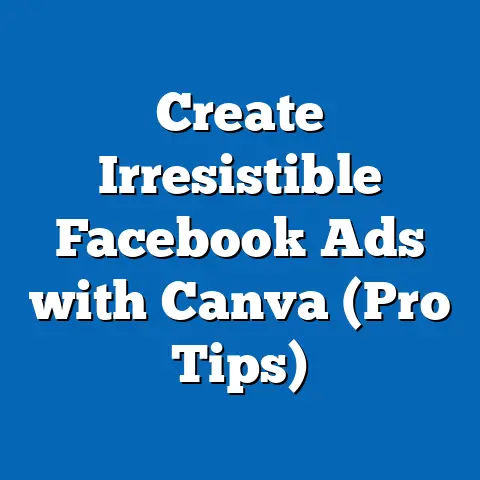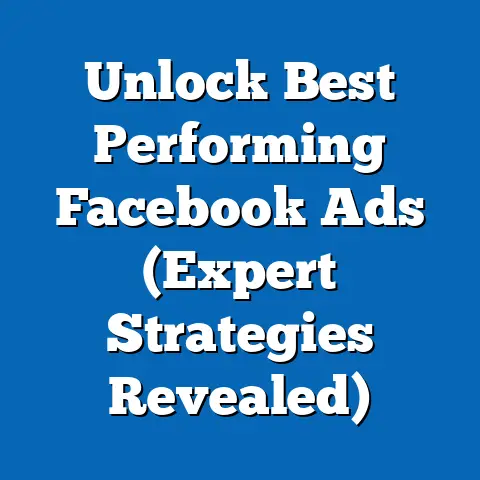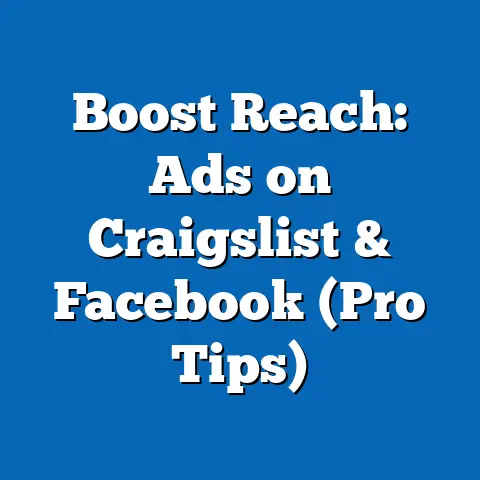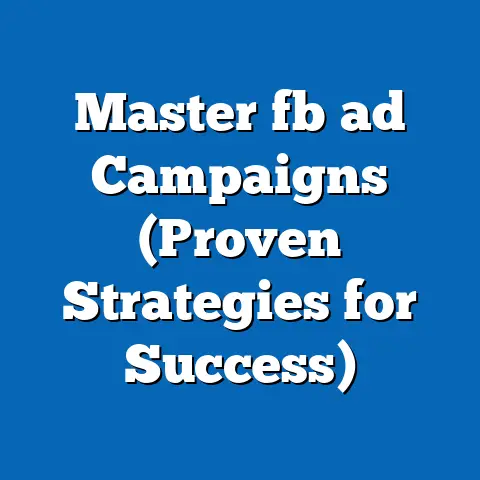Craft Captivating Facebook Ads Videos (Expert Strategies)
In an era where attention spans are shorter than ever, a well-crafted Facebook ads video can make or break a brand’s connection with its audience, capturing hearts and minds in mere seconds. As the digital landscape evolves at a breakneck pace, video content has emerged as the cornerstone of effective marketing, especially on platforms like Facebook, where billions of users scroll through feeds daily. Mastering the art of creating engaging, impactful ads videos is no longer optional—it’s a necessity for businesses aiming to thrive in a hyper-competitive online world.
Section 1: The Rise of Video Advertising on Facebook – A Historical Perspective
The advent of social media transformed advertising from static billboards and print media to dynamic, interactive experiences. Facebook, launched in 2004, quickly became a global hub for social interaction, and by 2012, it introduced video ads as a way for brands to engage users more deeply. This shift marked a turning point, aligning with the growing consumption of online video content, fueled by faster internet speeds and the proliferation of smartphones.
Historically, advertising relied on television and radio to capture mass audiences, but the digital age ushered in targeted, personalized marketing. The introduction of Facebook’s video ads coincided with the rise of Millennials as a dominant consumer force, a generation comfortable with technology and hungry for authentic, visually engaging content. Over the years, video ads evolved from simple promotional clips to sophisticated storytelling tools, driven by data analytics and algorithmic targeting.
The societal implications of this shift are profound. Video ads on Facebook have democratized advertising, allowing small businesses to compete with industry giants through creativity rather than budget. However, they’ve also raised concerns about data privacy, ad saturation, and the psychological impact of constant exposure to curated content. As we move forward, understanding this historical backdrop is crucial for crafting videos that not only sell but also resonate on a cultural level.
Section 2: Defining Characteristics of Captivating Facebook Ads Videos
What makes a Facebook ads video stand out in a sea of endless scrolling? Experts agree that successful videos share several key characteristics, regardless of the target audience or product. These include brevity, emotional resonance, visual appeal, and a clear call-to-action (CTA).
Brevity is paramount—most users decide within the first 3-5 seconds whether to keep watching. According to a 2022 study by HubSpot, videos under 15 seconds have the highest engagement rates on social platforms. This aligns with the fast-paced consumption habits of younger generations like Gen Z, who prioritize quick, digestible content.
Emotional resonance is another critical factor. Videos that evoke joy, nostalgia, or empathy tend to perform better, as they forge a personal connection with viewers. For instance, campaigns that tell a story—whether it’s a customer’s journey or a brand’s mission—often see higher shares and comments, metrics that Facebook’s algorithm rewards.
Visual appeal cannot be overstated. High-quality production, vibrant colors, and dynamic editing capture attention instantly, especially on mobile devices where most users access Facebook. Finally, a clear CTA, whether it’s “Shop Now” or “Learn More,” guides viewers on the next step, ensuring the ad’s purpose isn’t lost in creativity.
These characteristics are not one-size-fits-all, however. A video targeting Baby Boomers might lean on nostalgia and trust-building, while one for Gen Z could prioritize humor and trendiness. Understanding these nuances is key to crafting ads that captivate across generations.
Section 3: Generational Dynamics in Video Ad Engagement
Generational differences play a significant role in how audiences interact with Facebook ads videos. Each cohort—Baby Boomers (born 1946-1964), Generation X (1965-1980), Millennials (1981-1996), and Generation Z (1997-2012)—brings unique values, experiences, and technological fluency to the table. Tailoring content to these differences can dramatically improve engagement.
Baby Boomers grew up in a post-war era of economic growth and traditional media. They value authenticity and are more likely to respond to ads that emphasize reliability, family values, or nostalgia. Videos for this group should use clear language, avoid overly trendy slang, and focus on practical benefits.
Generation X, often called the “forgotten generation,” bridges the analog and digital worlds. Having adapted to technology later in life, they appreciate straightforward messaging but are also drawn to humor and pop culture references from the 80s and 90s. Ads targeting Gen X should balance innovation with relatability, often highlighting quality and value.
Millennials, the first truly digital generation, came of age during the internet boom and the 2008 financial crisis. They prioritize experiences over possessions and respond well to socially conscious brands. Videos for Millennials often succeed with storytelling that aligns with their values—think sustainability or diversity—and a tone that feels personal rather than corporate.
Generation Z, the true digital natives, have never known a world without smartphones or social media. Their attention spans are short, but their ability to spot inauthenticity is razor-sharp. Ads for Gen Z must be fast-paced, visually striking, and often tied to viral trends or influencers they trust.
While these generational profiles provide a framework, it’s critical to avoid stereotypes. Within each group, there’s immense diversity based on geography, income, and personal interests. Marketers must use data-driven insights, such as Facebook’s Audience Insights tool, to refine targeting and ensure videos resonate on an individual level.
Section 4: Technological and Cultural Factors Shaping Video Ads
The effectiveness of Facebook ads videos is deeply tied to technological advancements and cultural shifts. On the tech front, the rise of mobile-first viewing has reshaped video formats. Over 90% of Facebook users access the platform via mobile devices, according to Statista (2023), necessitating vertical or square videos optimized for small screens.
Autoplay and silent playback are other technological quirks that influence design. Since videos on Facebook often play without sound initially, captions and bold visuals are essential to grab attention. Moreover, AI-driven tools now allow marketers to test multiple ad variations instantly, optimizing for engagement in real-time.
Culturally, the demand for authenticity has never been higher. Across generations, users are skeptical of overly polished or salesy content. A 2021 survey by Edelman found that 63% of consumers trust user-generated content over traditional ads. This trend pushes brands to create videos that feel raw, relatable, or community-driven.
Social movements also shape content. For instance, the push for inclusivity means ads must reflect diverse faces and stories to avoid alienating audiences. Similarly, humor and memes—central to Gen Z culture—have become powerful tools for virality, though they require a delicate balance to avoid seeming forced.
These technological and cultural factors aren’t static; they evolve with each passing year. Marketers must stay agile, experimenting with new formats like augmented reality (AR) filters or interactive polls to keep pace with both tech and societal trends.
Section 5: Expert Strategies for Crafting Captivating Facebook Ads Videos
Drawing from industry leaders and data-backed research, here are expert strategies to create Facebook ads videos that captivate and convert. These approaches blend creativity with analytics, ensuring broad appeal while targeting specific generational nuances.
1. Start with a Hook (First 3 Seconds): The opening frame must stop the scroll. Use a striking visual, a bold question, or an unexpected sound to hook viewers instantly. For example, a fitness brand might open with a dramatic before-and-after shot, while a fashion brand could showcase a trending dance move.
2. Tell a Micro-Story: Even in a 15-second ad, storytelling is powerful. Focus on a relatable problem and a quick solution, or highlight a customer’s mini-journey. Millennials and Gen X often respond to narratives of personal growth, while Gen Z appreciates quirky, humorous micro-stories.
3. Optimize for Silent Viewing: Since many users watch without sound, include captions or on-screen text for key messages. Ensure visuals alone can convey the core idea—think bold graphics or expressive facial reactions. This is especially critical for mobile-first audiences across all generations.
4. Leverage User-Generated Content (UGC): Encourage customers to share their experiences with your product and feature these in ads. UGC builds trust, particularly with Millennials and Gen Z, who value peer recommendations over polished brand content. A 2022 Nielsen report noted that 92% of consumers trust UGC more than traditional ads.
5. Incorporate Trends and Influencers: For younger audiences, aligning with viral trends or partnering with micro-influencers can boost credibility. A Gen Z-targeted ad might use a trending TikTok sound, while a Millennial-focused campaign could feature a niche influencer discussing mental health alongside your product.
6. Test and Iterate with Data: Use Facebook’s A/B testing tools to experiment with different video lengths, CTAs, and visuals. Analyze metrics like click-through rates (CTR) and watch time to refine your approach. For instance, if Baby Boomers in your audience prefer longer explainer videos, adjust accordingly.
7. Focus on Emotional Triggers: Tap into emotions like humor, nostalgia, or inspiration based on your target demographic. A pet food brand might show a heartwarming reunion for Boomers, while a tech gadget ad for Gen Z could use witty banter. Emotional resonance drives shares, amplifying reach organically.
8. Design for Mobile and Accessibility: Use vertical (9:16) or square (1:1) formats for better mobile visibility. Ensure text is legible on small screens and consider accessibility features like descriptive captions for hearing-impaired users. This inclusivity resonates across generations.
These strategies aren’t isolated tactics but part of a cohesive approach. The best ads combine several elements, adapting to audience feedback and platform updates. Collaboration between creative teams and data analysts is essential to strike this balance.
Section 6: Economic and Workplace Implications of Video Advertising
The rise of video ads on Facebook has far-reaching economic implications. For businesses, video content offers a cost-effective way to reach global audiences, leveling the playing field for startups and small enterprises. Unlike traditional TV ads, which require hefty budgets, a well-made Facebook video can go viral with minimal spend, thanks to organic sharing and precise targeting.
However, this also intensifies competition. Companies must invest in skilled videographers, editors, and social media strategists to stand out, creating new job roles in digital marketing. The gig economy has benefited too, with freelancers offering specialized services like animation or influencer outreach.
In the workplace, video advertising has shifted how marketing teams operate. Cross-generational collaboration is key—older employees might bring storytelling expertise, while younger staff excel in trendspotting and tech tools. Companies must foster inclusive environments where diverse perspectives shape ad campaigns.
Economically, the reliance on data-driven ads raises ethical questions. Over-targeting or manipulative content can erode consumer trust, potentially leading to regulatory pushback. Brands must balance profit motives with transparency to maintain long-term loyalty across generations.
Section 7: Societal and Cultural Impacts of Facebook Ads Videos
Beyond economics, Facebook ads videos influence societal norms and cultural values. They shape perceptions of beauty, success, and lifestyle, often reflecting—or challenging—dominant trends. For instance, ads promoting body positivity have gained traction among Millennials and Gen Z, pushing back against decades of unrealistic standards.
However, the constant barrage of ads can contribute to digital fatigue, particularly among younger users. A 2023 Pew Research study found that 54% of Gen Z users feel overwhelmed by social media content, including ads. This suggests a need for brands to prioritize quality over quantity, focusing on meaningful engagement.
Culturally, video ads act as a mirror to generational shifts. They’ve popularized slang, memes, and micro-trends, often blurring the line between entertainment and marketing. Yet, this can also lead to cultural appropriation or tone-deaf campaigns if brands misstep, as seen in several high-profile ad controversies.
On a positive note, video ads have amplified social causes. Campaigns around climate change or mental health awareness often resonate with socially conscious generations, fostering dialogue. Brands that align with these values can build deeper connections, though authenticity remains critical to avoid accusations of “cause-washing.”
Section 8: Challenges and Nuances in Video Ad Creation
Creating captivating Facebook ads videos isn’t without challenges. One major hurdle is platform saturation—users are bombarded with content, making it harder to stand out. Even a well-crafted video can get lost if timing or targeting is off.
Generational diversity adds another layer of complexity. A humorous ad for Gen Z might alienate Baby Boomers, while a nostalgic campaign for older audiences could seem irrelevant to younger viewers. Striking a universal tone while maintaining specificity requires meticulous planning and testing.
Budget constraints also pose issues, especially for smaller brands. High-quality production often demands resources, yet low-budget ads can still succeed with creativity and authenticity. User-generated content or minimalist designs are viable alternatives, proving that innovation often trumps expense.
Finally, ethical dilemmas around data usage and psychological targeting loom large. While personalization boosts engagement, it risks crossing into manipulation. Marketers must navigate these waters carefully, adhering to evolving privacy laws like GDPR and CCPA while respecting user boundaries.
Section 9: Forward-Looking Insights and Uncertainties
As we look to the future, the landscape of Facebook ads videos will continue to evolve with technology and generational shifts. Emerging tools like AI-generated content and immersive AR experiences promise to redefine engagement, offering hyper-personalized ads that adapt in real-time. However, their accessibility and ethical implications remain uncertain.
The rise of Generation Alpha (born 2013 onwards) will also shape strategies. As the most digitally immersed cohort yet, their expectations for interactivity and authenticity will push brands to innovate further. Will traditional video formats suffice, or will interactive, gamified ads become the norm?
Regulatory changes around data privacy and ad transparency could disrupt current practices. Governments worldwide are scrutinizing platforms like Facebook, and stricter rules might limit targeting capabilities. Marketers must prepare for a future where trust and creativity outweigh algorithmic precision.
Finally, the balance between human creativity and automation remains an open question. While AI can optimize ads, the emotional depth of human storytelling is irreplaceable. The most successful brands will likely be those that merge data with empathy, crafting videos that resonate across generations.
Conclusion
Crafting captivating Facebook ads videos is both an art and a science, requiring a deep understanding of generational dynamics, technological trends, and cultural nuances. From the historical rise of digital advertising to the modern strategies that drive engagement, this medium offers unparalleled opportunities for connection—if executed thoughtfully. By prioritizing brevity, emotion, and authenticity, brands can cut through the noise and build lasting relationships with diverse audiences.
Yet, the journey is far from static. As societal values shift and new generations emerge, marketers must remain adaptable, balancing innovation with ethical responsibility. The future of video advertising on Facebook holds immense potential, but also unanswered questions about privacy, saturation, and cultural impact. One thing is certain: those who master the craft of captivating videos today will be best positioned to shape the digital conversations of tomorrow.





